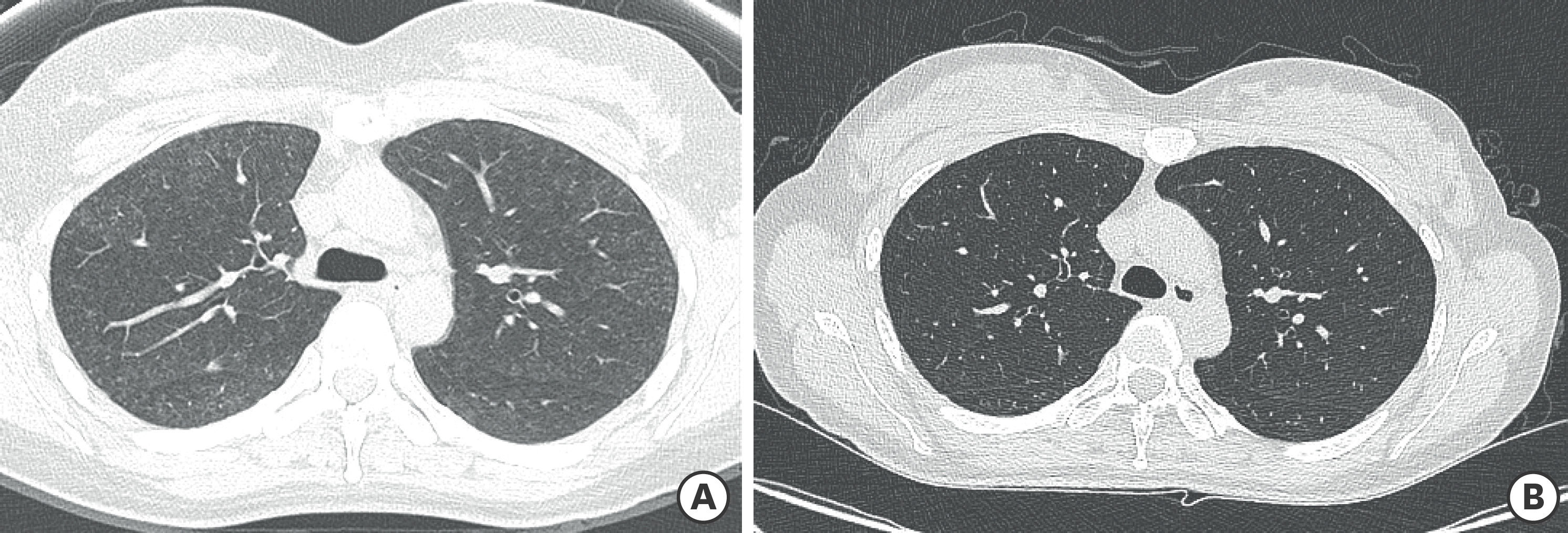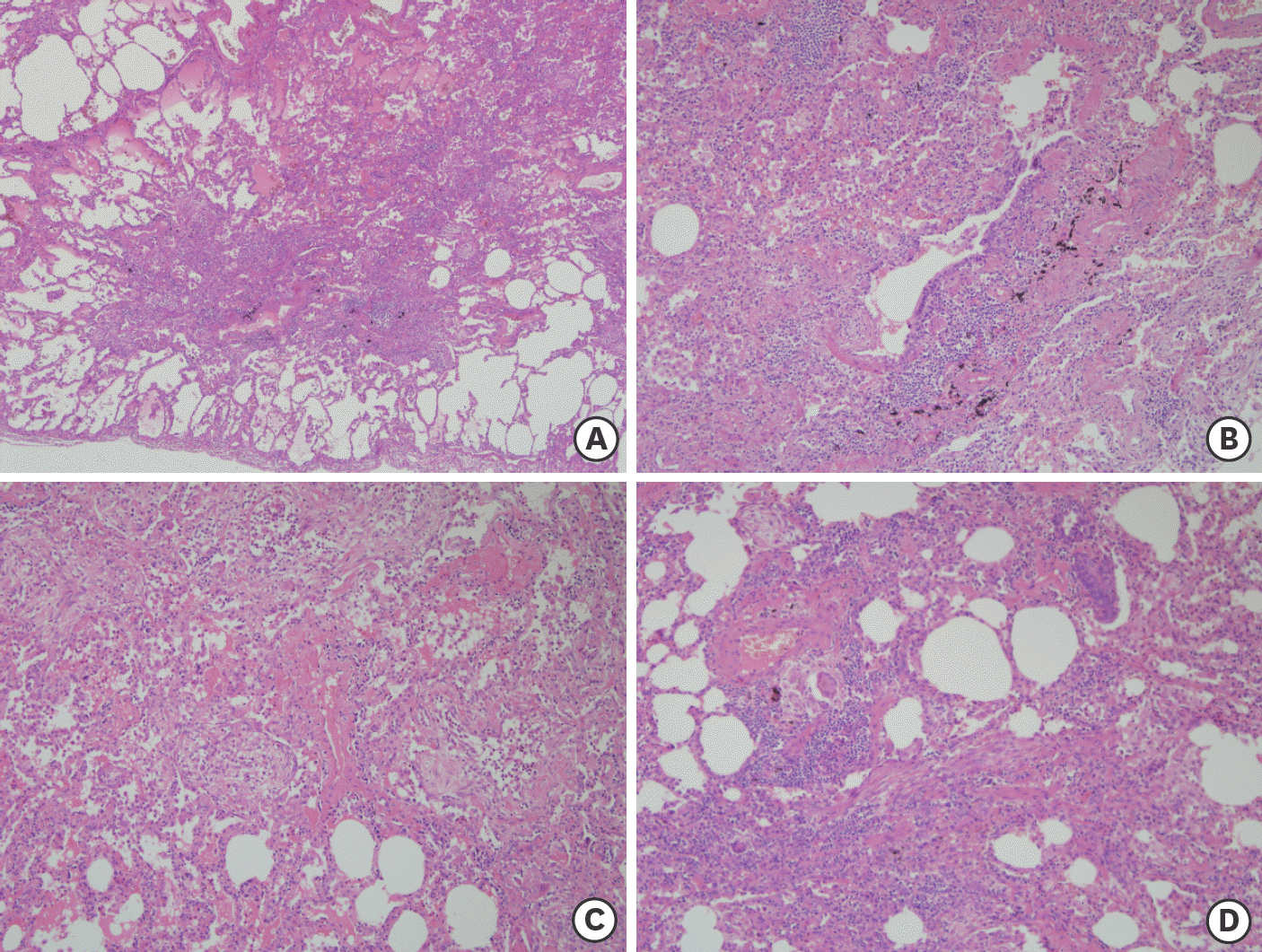Abstract
Background
In Korea, to investigate the casual relationship between humidifier disinfectant and lung disease, four rounds of investigation and judgment were conducted. During this investigation, two adults who performed lung biopsy were recognized for their relevance between humidifier disinfectants and lung disease. At first, we did not think of the relationship to humidifier disinfectant because chest computed tomography (CT) finding of 2 cases were improved. However, they performed lung biopsy and it showed typical humidifier disinfectant lung injury (HDLI) pathologic findings, they could be recognized as HDLI. We report these cases here.
Case presentation
We selected 2 cases from the fourth-round investigation at Kangbuk Samsung Hospital. Patient of case 1 used humidifier disinfectants since September 2010. The patient was admitted 6 months later to the intensive care unit (ICU) due to severe dyspnea. Pathology following a lung biopsy revealed typical HDLI finding which was determined to be due to humidifier disinfectant exposure. Patient of case 2 used humidifier disinfectant from 2001 to 2008 for about 3 months each winter. The patient's cough and sputum production symptoms began in December of 2007. The patient was admitted to the respiratory medicine department due to worsening dyspnea. Pathology following a lung biopsy revealed typical HDLI finding. This was determined to have been caused by humidifier disinfectant exposure.
Go to : 
References
1. Park DU, Ryu SH, Lim HK, Kim SK, Choi YY, Ahn JJ, et al. Types of household humidifier disinfectant and associated risk of lung injury (HDLI) in South Korea. Sci Total Environ. 2017; 596–597:53–60.

2. Kim KW, Ahn K, Yang HJ, Lee S, Park JD, Kim WK, et al. Humidifier disinfectant-associated children's interstitial lung disease. Am J Respir Crit Care Med. 2014; 189(1):48–56.
3. Huh JW, Hong SB, Do KH, Koo HJ, Jang SJ, Lee MS, et al. Inhalation lung injury associated with humidifier disinfectants in adults. J Korean Med Sci. 2016; 31(12):1857–62.

4. Koo HJ, Do KH, Chae EJ, Kim HJ, Song JS, Jang SJ, et al. Humidifier disinfectant-associated lung injury in adults: prognostic factors in predicting short-term outcome. Eur Radiol. 2017; 27(1):203–11.

5. Choi JE, Hong SB, Do KH, Kim HJ, Chung S, Lee E, et al. Humidifier disinfectant lung injury, how do we approach the issues? Environ Health Toxicol. 2016; 31:e2016019.
6. Paek D, Koh Y, Park DU, Cheong HK, Do KH, Lim CM, et al. nationwide study of humidifier disinfectant lung injury in South Korea, 1994–2011. Incidence and dose-response relationships. Ann Am Thorac Soc. 2015; 12(12):1813–21.

7. KEITI. Lung disease health damage investigation result (1st∼4th). 2019. https://www.healthrelief.or.kr/home/content/stats01/view.do. Accessed 18 Nov 2019.
8. Lee E, Seo JH, Kim HY, Yu J, Jhang WK, Park SJ, et al. Toxic inhalational injury-associated interstitial lung disease in children. J Korean Med Sci. 2013; 28(6):915–23.

9. Kim WY, Hong SB. Humidifier disinfectant-associated lung injury: six years after the tragic event. Tuberc Respir Dis. 2017; 80(4):351–7.

10. Spagnolo P, Rossi G, Cavazza A, Bonifazi M, Paladini I, Bonella F, et al. Hypersensitivity pneumonitis: a comprehensive review. J Investig Allergol Clin Immunol. 2015; 25(4):237–50.
Go to : 
 | Fig. 1.(A) Case 1 chest HRCT (at the time of first hospital visit): It shows the appearance of an acute diffuse interstitial lung disease such as acute eosinophilic pneumonia, hypersensitivity pneumonitis, diffuse alveolar damage, or interstitial pneumonia. Symmetrically distributed GGOs and small centrilobular nodules were observed. (B) A chest HRCT of case 1 (taken 6 years after discontinuing humidifier disinfectant at Kangbuk Samsung Hospital): Symmetrically distributed GGOs, small centrilobular nodules of both lungs at the initial CT were disappeared. HRCT: high resolution computed tomography; GGO: ground glass opacity; CT: computed tomography. |
 | Fig. 2.(A) Initial chest HRCT of case 2 (at the time of first hospital visit): It shows diffuse ground glass opacity, centrilobular ground glass opacity and nodules, and mild fibrosis in right upper lobe with calcified nodules. (B) Chest HRCT of case 2 (taken 9 years after discontinuing humidifier disinfectant use at Kangbuk Samsung Hospital): Centrilobular GGOs and peribronchial GGOs that were initially present in both lungs were disappeared. A postinfectious granuloma of RUL and diffuse air trapping in both lungs were observed. HRCT: high resolution computed tomography; GGO: ground glass opacity; RUL: right upper lobe. |
Table 1.
Radiologic criteria for humidifier disinfectant lung injury classification [6]
Table 2.
General evaluation classification and definition for HDLI levels [5]
Table 3.
Case 1 and case 2 PFT results
Table 4.
Comparison of first hospital and Kangbuk Samsung Hospital visit of case 1 patient
Table 5.
Comparison of first hospital and Kangbuk Samsung hospital visit of case 2 patient




 PDF
PDF Citation
Citation Print
Print



 XML Download
XML Download